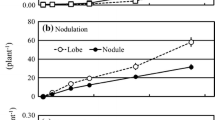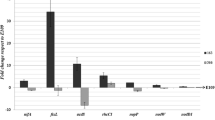Abstract
Combined light and transmission electron microscopy were used to examine the effect of nitrate on the development of root nodules in lucerne (alfalfa, Medicago sativa L.) following induction by the nitrogen-fixing symbiont, Rhizobium meliloti. The timing of NO -3 addition was varied in order to study its effect on all of the recognized morphogenetic steps of nodule formation. Roots of plants inoculated in the presence of 18 mM NO -3 had straight root hairs which were devoid of adherent rhizobia and infection threads, and developed no nodules. However, nodules were formed on roots if 18 mM NO -3 was added 5 d after inoculation. At this time, the initiation of nodule primordia had already commenced in the root cortex. The histology and ultrastructure of young nodules which had developed for 5 d in the absence of NO -3 and another 5 d in the presence of 18 mM NO -3 resembled nodules developing under N-free conditions, except that in the infection threads within the infection zone of the nodule 1) some bacteria tended to loose their normal shape and gain more electron density, indicating premature degradation, and 2) the matrix of the infection threads was abnormally enlarged. In the presence of high NO -3 levels in the medium, lysis and degeneration of the bacteria released from the infection threads were observed in the infection and bacteroid zones of developing nodules, indicative of premature senescence. On the other hand, the nodule meristems continued to proliferate even after 12 d of exposure of 18 mM NO -3 . This was the only morphogenetic step of root nodulation which was insensitive to levels of combined nitrogen that completely prevented infection if present at the time of inoculation. These data indicate that all of the recognized steps of root nodule morphogenesis in which the bacteria play a key role are sensitive to the inhibitory effect of combined nitrogen.
Similar content being viewed by others
References
Dart, P.J., Mercer, F.V. (1965) The influence of ammonium nitrate on the fine structure of nodules of Medicago tribuloides Desr. and Trifolium subterraneum L. Arch. Mikrobiol. 51, 233–257
Dazzo, F.B., Brill, W.J. (1978) Regulation by fixed nitrogen of host-symbiont recognition in the Rhizobium-clover symbiosis. Plant Physiol. 62, 18–21
Fahraeus, G. (1957) The infection of clover root hairs by nodule bacteria studied by a simple glass slide technique. J. Gen. Microbiol. 16, 374–381
Fred, E.B., Baldwin, I.L., McCoy, E. (1932) Root nodule bacteria and leguminous plants. University of Wisconsin Press, Madison, Wis.
Gibson, A.H., Pagan, J.D. (1977) Nitrate effects on the nodulation of legumes inoculated with nitrate-reductase-deficient mutants of Rhizobium. Planta 134, 17–22
Huber, J.D., Parker, F., Odland, G.F. (1968) A basic fuchsin and alkanized methylene blue rapid stain for epoxy embedded tissue. Stain Technol. 43, 83–87
Kijne, J.W. (1975) The fine structure of pea root nodules. I. Vacuolar changes after endocytotic host cell infection by Rhizobium leguminosarum. Physiol. Plant Pathol. 5, 75–79
Libbenga, K.R., Harkes, P.A.A. (1973) Initial proliferation of cortical cells in the formation of root nodules in Pisum sativum. Planta 114, 17–28
Libbenga, K.R., van Iren, F., Bogers, R.J., Schraag-Lamers, M.F. (1973) The role of hormones and gradients in the initiation of cortex proliferation and nodule formation in Pisum sativum L. Planta 114, 29–39
Munns, D.N. (1968) Nodulation of Medicago sativa in solution culture. III. Effects of nitrate on root hairs and infection. Plant Soil 29, 33–49
Newcomb, W. (1980) Control of morphogenesis and differentiation of pea root nodules. In: Nitrogen fixation, vol. 12. pp. 87–102, Newton, W., Orme-Johnson, W., eds. University Park Press, Baltimore, Md.
Phillips, D.A. (1971) Abscissic acid inhibition of root nodule initiation in Pisum sativum. Planta 100, 181–190
Thornton, H.G. (1936) The action of sodium nitrate upon the infection of lucerne root-hairs by nodule bacteria. Proc. R. Soc. Lond. B 119, 474–492
Thornton, H.G., Rudorf, J.E. (1936) The abnormal structure induced in nodules on lucerne (Medicago sativa L.) by the supply of sodium nitrate to the host plant. Proc. R. Soc. Lond. B 120, 240–252
Truchet, G. (1978) Sur l'état diploide des cellules du méristème des nodules radiculaires de Légumineuses. Ann. Sci. Nat., Bot. Biol. Vég. 19, 3–38
Truchet, G., Michel, M., Dénarié, J. (1980) Sequential analysis of the organogenesis of lucerne (Medicago sativa) root nodules using symbiotically-defective mutants of Rhizobium meliloti. Differentiation 16, 163–172
Vincent, J.M. (1970) A manual for the practical study of root-nodule bacteria. Int. Biol. Prog. Hdbk. No. 15. Blackwell, Oxford
Wilson, J.K. (1916) Physiological studies of Bacillus radicicola of soybean (Soja max piper) and of factors influencing nodule production. New York (Cornell) Agric. Exp. Stat. Bull. 386, 369–413
Author information
Authors and Affiliations
Rights and permissions
About this article
Cite this article
Truchet, G.L., Dazzo, F.B. Morphogenesis of lucerne root nodules incited by Rhizobium meliloti in the presence of combined nitrogen. Planta 154, 352–360 (1982). https://doi.org/10.1007/BF00393915
Received:
Accepted:
Issue Date:
DOI: https://doi.org/10.1007/BF00393915




